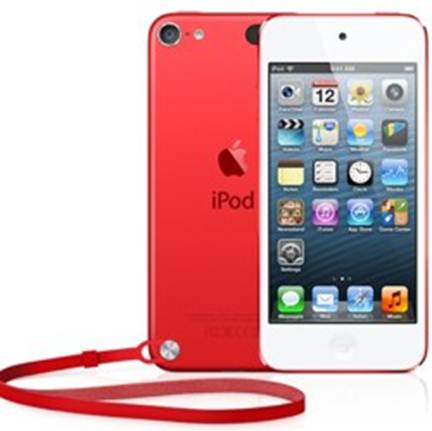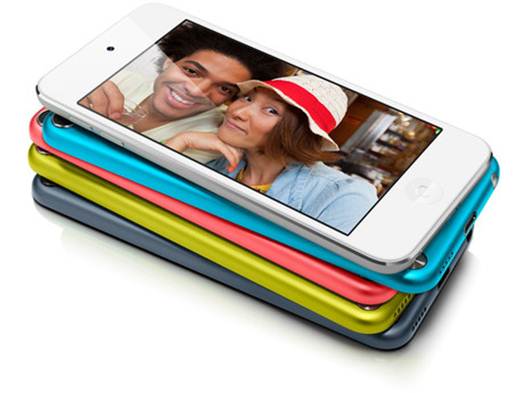Who needs an iPod anyway? With its
functions subsumed into the all-conquering smartphone, the device that
propelled Apple into the mass market could start to look redundant. Yet iPods
still sell in their millions and these two new models should keep the flame
very much alive…
iPod touch 5th gen
THE FIFTH GENERATION iPod touch is an incredibly thin device, even compared to the
slimmed-down iPhone 5. It’s so thin, in fact, that you might wonder if it’s
going to be too flakey to survive daily life. But in shaving down the case
thickness, Apple certainly hasn’t cut any corners on the build quality. Despite
feeling almost comically light in your hand, the touch is still convincingly
sturdy. You won’t feel like you’re going to break it, whether while using it or
while carrying it around. It’s ideal for a front pocket, since it’s light
enough not to bend even a shirt out of shape, and in ours it showed no risk of
coming to any harm.

iPod
touch 5th gen
As usual, the iPod touch is essentially the
same shape and size as the contemporary iPhone, but with its own distinctive
finish. And this time it’s more than different enough to counter the cavil that
‘it’s just an iPhone without the phone’. While the engineering is as surgically
crisp as the iPhone 5’s and that’s high praise – the iPod’s first impression is
quite different.
For a start, it comes in four colours as
well as black and silver, all with the same white front (matching the white
iPhone). The colours are dyed into the aluminium, not painted on, so they’ll
never chip off.
Apple has a history of launching devices in
a variety of colours only to find that some of them are dramatically more
popular than others, and we’re a bit skeptical about the appeal of the acid
green and hot pink choices, but you never can tell. There’s a (PRODUCT)RED
version if you prefer. The blue is a classic, and if you like mono-chrome then
the silver or black option will be the kind of thing you like.
The last of these has something of the
‘stealth’ look of the black iPhone 5, since all of the colours are subtly matt,
giving a beautiful feel in the hand. Rather than having a band separating its
front and back surfaces, like the iPhone, the iPod has a curved back panel that
meets the front edge; this time the curve is much tighter, really just rounding
off a square edge, and at the front there’s a fine polished bevel, again
reminiscent of the iPhone 5.
The cameras, ports and switches are also in
similar places, including the tiny Lightning connector that replaces the 30-pin
Dock and here you really appreciate why: there simply isn’t room for that
clunky old interface in this ultra slim case.

Apple
has a history of launching devices in a variety of colours
Something else that’s identical to the
iPhone 5 is the superb 4in widescreen Retina display. It’s this that really
sets the touch apart from other music players and handheld game consoles. While
the previous iPod touch had the same resolution as the iPhone 4S, the quality
was way off. The 5th generation touch still doesn’t have exactly the
same panel as the iPhone 5 given the difference in price between the two,
compromises are to be expected all round but it’s a lot closer in appearance,
and noticeably more vibrant and less mushy than its predecessor.
Of course, it’s also taller, although it
makes more sense to think of it as wider, since that’s the way movies and many
games will make use of the extra space. Although it’s obviously not the biggest
screen around on a pocket entertainment device, the balance between portability
and screen area is a very practical one.
It’s said that iOS is now the world’s most
popular gaming platform, and when you consider that the touch gives you access
to around 175,000 entertainment titles on the App Store, the majority of them
costing a couple of quid or less, that’s hardly surprising. Of course, that’s
still just a fraction of the 700,000 apps available.
Those apps will be running on the A5
processor, the same ‘system on a chip’ that was used in the iPhone 4S. As
before, it’s a generation behind the current iPhone, but bearing in mind that
the 4S is still on sale starting at $674 with 16GB of storage (the iPod touch
starts at $374 with 32GB) this is not to be sniffed at; it makes more ambitious
games possible as well as ensuring everything feels slick and responsive.
THE IPOD TOUCH also benefits, of course, from iOS 6, with new features including
more comprehensive support for iCloud. If you don’t mind paying $33 a year for
iTunes Match, and you tend to buy your movies from the iTunes Store, you can
pretty much forget about connecting your iPod to your Mac and syncing content
from iTunes; everything can come via the cloud now (using a WI-FI connection),
and your device can back up to the cloud too. If you still need to get stuff in
and out of your Mac-based entertainment collection, you can at least sync via
WI-FI rather than cable, which saves some hassle. And iTunes 11, which should
be out by the time you read this, promises to make iTunes on the Mac more
usable and less annoying.

iOS
6
There’s still no GPS chip in the iPod
touch, so it can only find its location by scouting for nearby WI-FI networks
and matching them against Apple’s geographic database. In built up areas this
can be just as accurate as GPS, and faster, but off the beaten track your iPod
won’t find you as reliably as an iPhone. This also means turn by turn directions,
satnav-style, aren’t supported, but you do get Apple’s Maps app, with its other
impressive features, including Flyover with 3D buildings. It does still need
some work, but unless you happen to live in a particularly poorly served area,
Maps is really rather nice.
Perhaps the most unexpected feature of the
new iPod touch is the Loop. This is a simple faux-leather strap that attaches
to a clever little pop out cleat that sits flush with the back panel if you’re
not using it. It may seem superfluous, but after all cameras always come with
somewhere to attach a strap, and it’s very handy ether to make sure you don’t
drop the iPod while doing something fiddly or to help you hold it in a
comfortable position. If you don’t want to use it, nobody’s forcing you, but
it’s a nice detail with a practical purpose.